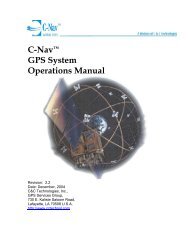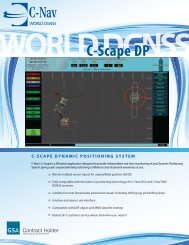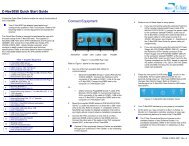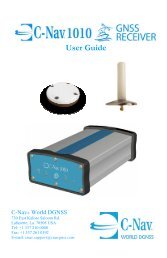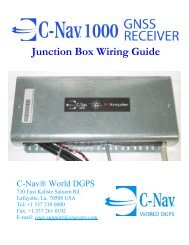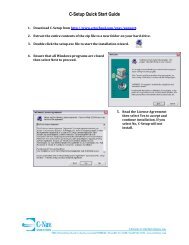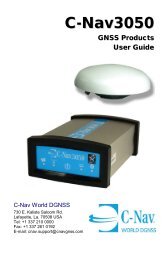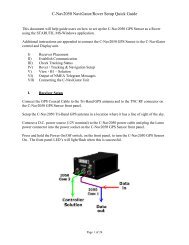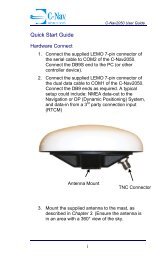Guidelines for the use of GNSS in surveying and mapping
Guidelines for the use of GNSS in surveying and mapping
Guidelines for the use of GNSS in surveying and mapping
Create successful ePaper yourself
Turn your PDF publications into a flip-book with our unique Google optimized e-Paper software.
process<strong>in</strong>g section <strong>of</strong> a f<strong>in</strong>al survey report as three<br />
dist<strong>in</strong>ct QC parameters <strong>for</strong> each static or dynamic<br />
basel<strong>in</strong>e solution accepted:<br />
+ RMS<br />
+ st<strong>and</strong>ard deviation <strong>of</strong> <strong>the</strong> basel<strong>in</strong>e components<br />
+ ratio, <strong>for</strong> fixed <strong>in</strong>teger basel<strong>in</strong>es.<br />
The manufacturer, type <strong>and</strong> version number <strong>of</strong> <strong>the</strong><br />
basel<strong>in</strong>e process<strong>in</strong>g s<strong>of</strong>tware should also be<br />
detailed <strong>in</strong> <strong>the</strong> survey report.<br />
In control surveys, once basel<strong>in</strong>es are successfully<br />
estimated <strong>and</strong> selected, loop closures should be<br />
computed around <strong>the</strong> geometric figure <strong>of</strong> <strong>the</strong><br />
network as a fur<strong>the</strong>r quality control check. This is a<br />
second key check to ensure basel<strong>in</strong>e estimation<br />
has been correctly achieved. This check is <strong>of</strong><br />
paramount importance when process<strong>in</strong>g large<br />
numbers <strong>of</strong> basel<strong>in</strong>es <strong>in</strong> batch jobs, as careful<br />
treatment <strong>of</strong> each basel<strong>in</strong>e is unlikely to have been<br />
carried out. As a general rule, <strong>for</strong> closures <strong>of</strong><br />
lengths between 10 <strong>and</strong> 50km, those exceed<strong>in</strong>g<br />
3ppm should be <strong>in</strong>vestigated. It should be noted<br />
that any misclosures left <strong>in</strong> <strong>the</strong> project will be<br />
propogated <strong>in</strong>to <strong>the</strong> f<strong>in</strong>al co-ord<strong>in</strong>ate error ellipses.<br />
Thus, if a specification requires f<strong>in</strong>al error ellipses<br />
to be better than 0.1m at 95 per cent, all<br />
misclosures <strong>of</strong> greater than 0.1m must be<br />
elim<strong>in</strong>ated to achieve <strong>the</strong> specification.<br />
Where a new s<strong>in</strong>gle po<strong>in</strong>t has been observed with<br />
reference to a number <strong>of</strong> base stations, <strong>the</strong> coord<strong>in</strong>ate<br />
recovery technique should be <strong>use</strong>d. The<br />
source control po<strong>in</strong>t nearest <strong>the</strong> new po<strong>in</strong>t is<br />
treated as base station to compute <strong>the</strong> new po<strong>in</strong>t.<br />
Then, from <strong>the</strong> new po<strong>in</strong>t, basel<strong>in</strong>es are computed<br />
out to <strong>the</strong> o<strong>the</strong>r source control stations. The<br />
difference between computed <strong>and</strong> published coord<strong>in</strong>ates<br />
will give an <strong>in</strong>dication <strong>of</strong> <strong>the</strong> accuracy <strong>of</strong><br />
<strong>the</strong> result, highlight<strong>in</strong>g dubious source control<br />
<strong>GNSS</strong> data.<br />
7.5.6 Network adjustment<br />
Follow<strong>in</strong>g <strong>the</strong> <strong>GNSS</strong> basel<strong>in</strong>e estimation with<strong>in</strong> <strong>the</strong><br />
basel<strong>in</strong>e process<strong>in</strong>g part <strong>of</strong> <strong>the</strong> s<strong>of</strong>tware, <strong>GNSS</strong><br />
vectors are generally passed to <strong>the</strong> network<br />
adjustment part <strong>of</strong> <strong>the</strong> s<strong>of</strong>tware. <strong>GNSS</strong> vectors <strong>and</strong><br />
<strong>the</strong> associated full covariance <strong>in</strong><strong>for</strong>mation should<br />
be passed across. However it should be noted that<br />
<strong>for</strong> float solutions, where <strong>the</strong> basel<strong>in</strong>es are still<br />
biased by <strong>the</strong> non-fixed <strong>in</strong>tegers, <strong>the</strong> covariant<br />
elements may be discarded prior to network<br />
adjustment.<br />
With<strong>in</strong> <strong>the</strong> network adjustment s<strong>of</strong>tware <strong>the</strong>re<br />
should be a capability to allow <strong>for</strong> different classes,<br />
or groups. This will allow different weight<strong>in</strong>g<br />
strategies to be adopted <strong>for</strong> different classes <strong>of</strong><br />
basel<strong>in</strong>e solutions, or <strong>for</strong> different types <strong>of</strong><br />
terrestrial observations. A comb<strong>in</strong>ation <strong>of</strong> k<strong>in</strong>ematic,<br />
rapid/fast static or static basel<strong>in</strong>es can <strong>the</strong>n be<br />
<strong>in</strong>cluded, with properly ascribed significance, <strong>in</strong> a<br />
common adjustment. The comb<strong>in</strong>ation <strong>of</strong> terrestrial<br />
observations with <strong>GNSS</strong> data is a complex field <strong>of</strong><br />
study, <strong>and</strong> appropriate specialist comb<strong>in</strong>ed network<br />
adjustment s<strong>of</strong>tware should always be <strong>use</strong>d by<br />
experienced personnel with substantial expertise if<br />
this is to be undertaken.<br />
7.5.7 Network statistical test<strong>in</strong>g <strong>and</strong><br />
measurement weight<strong>in</strong>g<br />
With<strong>in</strong> a network adjustment <strong>the</strong> <strong>in</strong>itial focus should<br />
be based around test<strong>in</strong>g <strong>of</strong> <strong>the</strong> <strong>in</strong>dividual<br />
measurements. A procedure follow<strong>in</strong>g <strong>the</strong><br />
computation <strong>of</strong> st<strong>and</strong>ardised residuals <strong>and</strong> <strong>the</strong>ir<br />
comparison aga<strong>in</strong>st a chi-squared probability test<br />
<strong>and</strong> <strong>the</strong> tau criterion is recommended, <strong>and</strong> should<br />
be <strong>in</strong>cluded <strong>in</strong> any s<strong>of</strong>tware. This may well take<br />
place as part <strong>of</strong> a prelim<strong>in</strong>ary, or free adjustment.<br />
With<strong>in</strong> this process it is recommended that only<br />
non-trivial (see section 7.2) basel<strong>in</strong>es are <strong>use</strong>d. This<br />
avoids <strong>the</strong> problems <strong>of</strong> ma<strong>the</strong>matically modell<strong>in</strong>g<br />
correlated measurements.<br />
Failure <strong>of</strong> test<strong>in</strong>g aga<strong>in</strong>st <strong>the</strong> chi-squared probability<br />
test <strong>and</strong> comparison aga<strong>in</strong>st <strong>the</strong> tau criterion may<br />
be ei<strong>the</strong>r representative <strong>of</strong> <strong>in</strong>adequate covariant<br />
<strong>in</strong><strong>for</strong>mation from <strong>the</strong> <strong>GNSS</strong> process<strong>in</strong>g stage,<br />
network geometry limitations or true measurement<br />
deficiencies. Failure <strong>of</strong> test<strong>in</strong>g should promote more<br />
evaluation <strong>and</strong> test<strong>in</strong>g <strong>of</strong> <strong>the</strong> network be<strong>for</strong>e f<strong>in</strong>ally<br />
decid<strong>in</strong>g upon explicit rejection <strong>of</strong> measurements.<br />
Once <strong>the</strong> f<strong>in</strong>al set <strong>of</strong> measurements have been<br />
tested <strong>and</strong> selected, <strong>the</strong> adjustment should<br />
proceed with <strong>the</strong> appropriate weight<strong>in</strong>g strategy<br />
applied. This is a vital aspect <strong>of</strong> any network<br />
adjustment as <strong>the</strong> f<strong>in</strong>al output <strong>of</strong> <strong>the</strong> station error<br />
ellipses are dependent on <strong>the</strong> weight<strong>in</strong>g strategy<br />
<strong>use</strong>d. For example, centr<strong>in</strong>g <strong>and</strong> height errors<br />
should be entered. In addition, <strong>the</strong> stations selected<br />
as control should be held fixed at <strong>the</strong>ir def<strong>in</strong>ed<br />
GUIDELINES FOR THE USE OF <strong>GNSS</strong> IN LAND SURVEYING AND MAPPING |57





